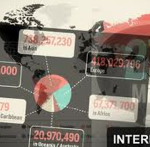
Video is on the rise with Youtube serving 2 billion videos every day, mostly (72%) watched by a small number (3) individuals. This is a very personal world of video publication with fewer than 12% of the content being watched by more than 6 people. Video on demand is growing very quickly and is consumer driven; 17% of people can watch on-demand on their TV whilst nearly 60% want this feature. Home networking restrictions (downloads to computers not being able to be watched on TV and vice-versa) is the biggest brake on this growth with half of the UK population wanting to download more content but only if it can be watched on any platform in their house.
Social networking is still growing and now accounts for 12% of all internet site visits with 2m people spending at least 1hr a day on social media sites. The networks are still growing (between 15 and 50%) the only real loser in this category is MySpace (-50%) and Windows Live which shows a 7% drop in users since last year. Twitter usage is up a staggering 60%. Top UK sites are Facebook (24m visitors per month), Twitter (3.7m), Flickr (2.9m), MySpace (2.7m) and LinkedIn (2.1m).
Anti-Facebook? Well this monster accounts for 1 in 6 of every page viewed in the UK (July 2010) and is the second most visited website (after Google) in the UK. This rise is meteoric, at the end of 2008 it was just 1 in 20 of the pages viewed. With around 500m active users a staggering 50% log on every day.
Wikipedia now has nearly 18m articles with 1m being added in the first half of 2010. There are just 85,000 active contributors.
Understanding of conversion rates and their importance in web strategy is starting to take hold. Average conversion from paid search (PPC) is now 2%, whilst organic search is 1.3%. Click fraud is on the rise (14% of all clicks versus 13% in 2009) with automated robots (Botnets) representing almost half of the fake clicks.
Email is still playing an important part with 36% of consumers citing email contact as a reason to make a purchase. Click-through rates from email is static at around 5%. Spam is one of the great threats to the continued survival of email; 91% of all email is now spam.
Advertising online in the UK is now the largest market segment having overtaken TV in late 2009. Approximately 3bn is spent on paid search and display, up 9% from 2009 and nearly a quarter of all advertising spend in the UK. CPM rates for banner are 25% lower whilst PPC rates are about 30% up on 2009. Reach for display banners is now 96% of UK users and it’s performance is incredibly sensitive to time of day – attention rates are 50% after 6pm, 11% lunchtime and 5% before 9am. Time to re-think your banner strategy?
Web analytics is receiving ever more attention with “cost per lead” being the highest priority and “drop-off rates” next on the list. Half of the UK budget of £100m is spent on internal staff and around one fifth of companies spend more than £50k per annum measuring Internet performance.
Site performance and uptime has a great bearing on overall performance with 99.9% uptime and page load speed of 2 seconds the new benchmarks.
Data and information came from a huge range of sources, too numerous to thank or mention here. All mistakes and errors are mine and mine alone and if you notice anything I’ve got wrong then email me please.
